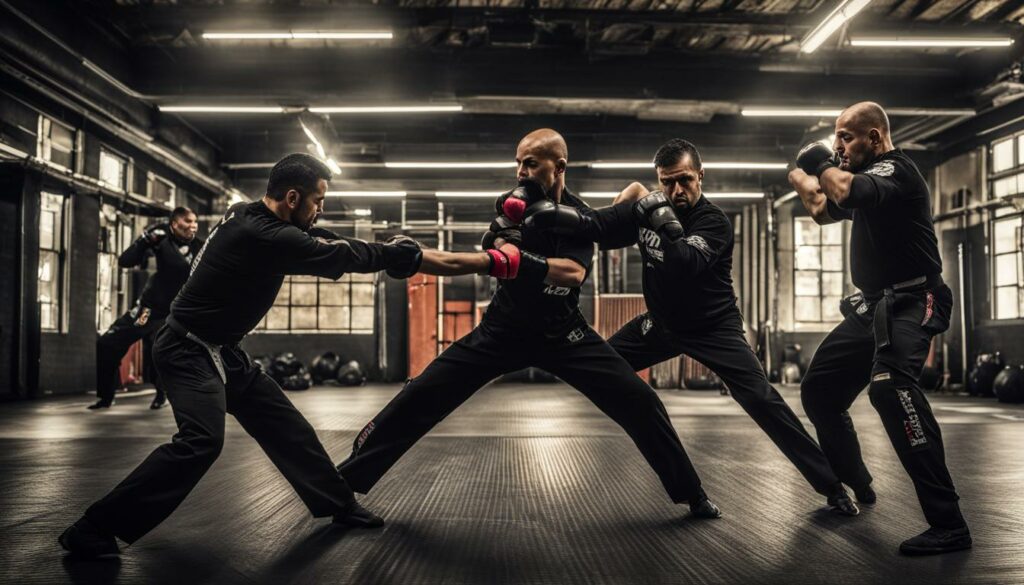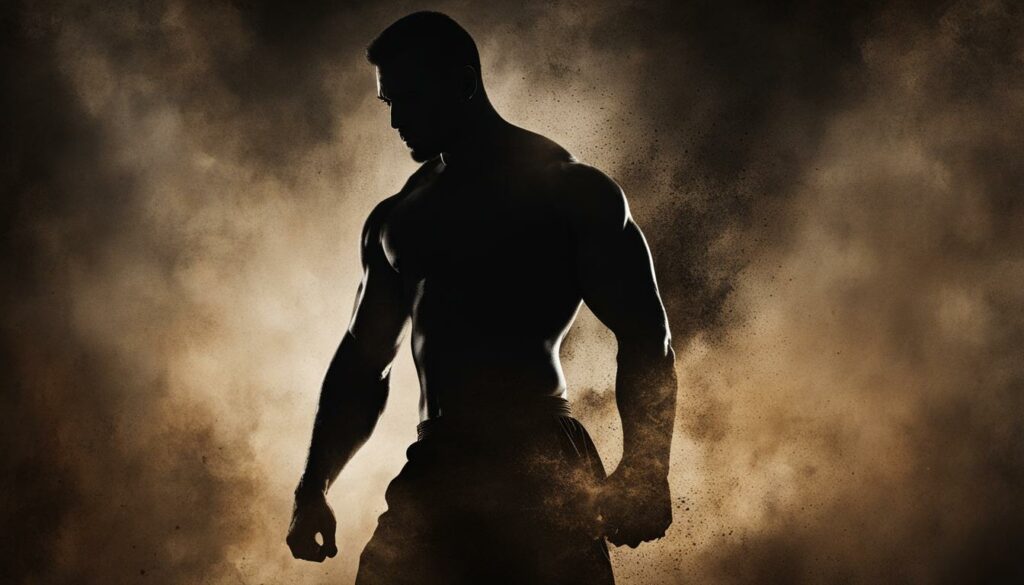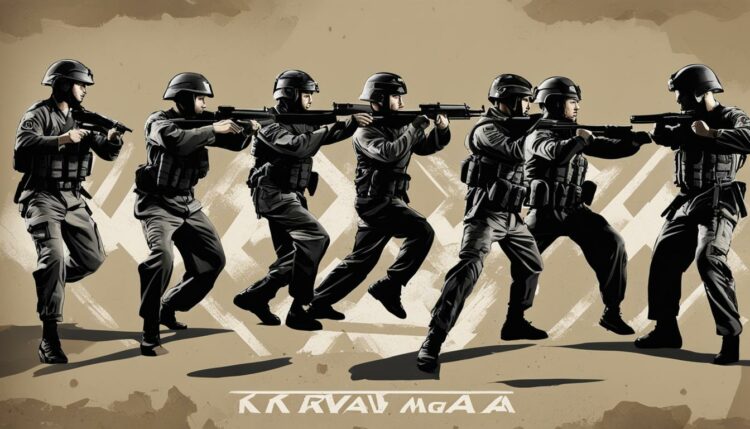Krav Maga, the renowned self-defense system, has a rich and fascinating history that traces back to its origins in Israel.
Developed by the esteemed martial artist and former boxer Imi Lichtenfeld, Krav Maga emerged in the 1930s as Lichtenfeld began teaching self-defense techniques to Bratislava, Slovakia Jewish residents.
This marked the genesis of a system that would later be refined and elevated as it became the official self-defense method of the Israeli Defense Forces in the 1940s.
Since its inception, Krav Maga has undergone significant evolution and development, gaining popularity worldwide as a highly effective martial art and self-defense method.
It draws upon Lichtenfeld’s extensive knowledge of martial arts, including boxing, wrestling, and Jiu-Jitsu, combining practical techniques and aggression to neutralize threats swiftly.
The Origins of Krav Maga
Krav Maga has its roots in the innovative mind of its founder, Imi Lichtenfeld. Born in Budapest, Hungary, Lichtenfeld was exposed to violence at an early age, which fueled his determination to develop a self-defense system that could protect individuals in real-life situations.
Drawing from his extensive knowledge of martial arts, including boxing, wrestling, and Jiu-Jitsu, Lichtenfeld created Krav Maga in the 1930s.
Recognizing the need for a system that could be quickly learned and effectively applied, Lichtenfeld refined Krav Maga as he migrated to Palestine.
During this time, he began teaching Krav Maga to the Israeli military, further developing and adapting the system to suit their needs.
The practicality and efficiency of Krav Maga made it the official self-defense system of the Israeli Defense Forces (IDF) in the 1940s, solidifying its reputation.
“My method’s aim is to teach the student how to deal with any situation by a series of simple, effective, and natural movements.”
The simplicity and effectiveness of Krav Maga quickly gained recognition beyond the Israeli military. Today, Krav Maga is practiced worldwide, attracting individuals from all walks of life who seek practical self-defense skills.
The system’s emphasis on real-life scenarios and the ability to neutralize threats quickly has made it a popular choice for military and law enforcement agencies.
The Vision of Imi Lichtenfeld
Imi Lichtenfeld’s vision for Krav Maga was to create a system that transcended traditional martial arts, focusing on practical techniques that could be applied in real-world situations.
He believed in simplicity and efficiency, teaching his students to respond instinctively and effectively to any threat they may encounter.
Lichtenfeld’s legacy lives on in the continued development and evolution of Krav Maga as practitioners strive to uphold his principles and adapt the system to modern self-defense needs.
The Evolution of Krav Maga
One area of evolution in Krav Maga is the training methods. The emphasis has shifted towards realistic scenarios and high-intensity workouts to prepare practitioners for real-life encounters better.
This practical approach ensures that individuals have the necessary skills and mindset to react quickly and effectively in dangerous situations.
Additionally, the techniques themselves have evolved to be more practical and efficient. Over time, adjustments and refinements have been made based on real-life experiences, practitioner feedback, and advances in understanding human physiology and psychology.
The evolution of Krav Maga has resulted in a system that focuses on neutralizing threats rapidly and effectively while minimizing the risk of injury to oneself.
The Influence of Krav Maga in the Martial Arts World

The emphasis on aggression, rapid response, and neutralizing threats quickly has been integrated into different martial arts styles and training methods, enhancing their effectiveness in real-life situations.
Not only has Krav Maga influenced individual practitioners, but it has also made its way into military and law enforcement training programs worldwide.
The self-defense techniques taught in Krav Maga have been incorporated into the training programs of military and law enforcement agencies, recognizing the practicality and effectiveness of the system in high-stress situations.
Krav Maga’s aggressive and practical approach to self-defense has led to its integration into various martial arts and training programs worldwide. Its focus on real-life scenarios and efficient techniques has made it a popular choice for individuals seeking practical self-defense skills.
| Impact of Krav Maga on the Martial Arts World | Details |
|---|---|
| Incorporation into various martial arts | Krav Maga techniques have been integrated into different martial arts styles, enhancing their effectiveness in real-life scenarios. |
| Inclusion in military and law enforcement training | The practical self-defense techniques of Krav Maga have been incorporated into the training programs of military and law enforcement agencies worldwide. |
| Shaping the mindset of self-defense practitioners | Krav Maga emphasizes situational awareness, confidence, and a never-give-up attitude, qualities embraced by practitioners of other martial arts. |
The Legacy of Imi Lichtenfeld

Imi Lichtenfeld, the founder of Krav Maga, has left behind a lasting legacy in the world of self-defense. His innovative approach to creating a practical and effective system has significantly impacted the martial arts community.
Lichtenfeld’s dedication to developing a self-defense system that could protect individuals in real-life situations has resonated with practitioners worldwide. His teachings and techniques continue to be passed down by Krav Maga instructors, ensuring that his legacy lives on.
Lichtenfeld’s emphasis on practicality, efficiency, and aggression instilled in Krav Maga has become synonymous with the system. This focus on real-world self-defense has attracted individuals from all walks of life, including military personnel, law enforcement officers, and everyday civilians.
The Popularity of Krav Maga Today
Krav Maga has become increasingly popular in recent years, gaining recognition as a highly effective self-defense system.
Its practicality and emphasis on real-life scenarios have attracted individuals from various backgrounds, including military personnel, law enforcement officers, and everyday civilians.
What sets Krav Maga apart is its focus on efficiency and aggression. Unlike traditional martial arts, Krav Maga prioritizes neutralizing threats quickly and decisively, enabling practitioners to defend themselves effectively in high-stress situations.
The demand for self-defense skills and the recognition of Krav Maga’s effectiveness have contributed to its widespread popularity. Krav Maga training centers can now be found in countries around the world, offering classes for people of all ages and fitness levels.
The Benefits of Krav Maga Training
- Improved self-confidence: Learning Krav Maga not only equips individuals with practical self-defense skills but also boosts their confidence in their ability to protect themselves and their loved ones.
- Enhanced physical fitness: Krav Maga training involves high-intensity workouts that improve cardiovascular endurance, strength, and overall fitness.
- Stress relief: The intense nature of Krav Maga workouts helps release stress and tension, providing a healthy outlet for daily frustrations.
- Increased situational awareness: Krav Maga teaches individuals to be aware of their surroundings and potential threats, enabling them to respond quickly and effectively.
The Future of Krav Maga
Krav Maga has recently gained popularity as a practical and effective self-defense system. But what does the future hold for this martial art?
One area where Krav Maga will likely see development is in its techniques and training methods. As new threats emerge and evolve, Krav Maga will incorporate new techniques and strategies to ensure its effectiveness in real-life situations.
This may involve integrating elements from other martial arts or developing new methods to neutralize threats quickly and efficiently. The goal will always be to provide practitioners with practical and realistic self-defense skills.
| Benefits of the Future of Krav Maga | Challenges of the Future of Krav Maga |
|---|---|
|
|
Conclusion
The history of Krav Maga is a testament to the ingenuity and innovation of its founder, Imi Lichtenfeld. Originating in the 1930s, this self-defense system has evolved and gained popularity worldwide.
Lichtenfeld’s vision of a practical and effective system that could protect individuals in real-life situations has become a reality.
From its humble beginnings teaching self-defense techniques to Jewish residents in Slovakia, Krav Maga became the Israeli Defense Forces (IDF’s) official self-defense system.
Over the years, it has influenced the martial arts world, focusing on practicality and real-life scenarios. Today, Krav Maga continues to be a popular choice for individuals seeking practical self-defense skills.
FAQ
When was Krav Maga developed?
Krav Maga was developed in the 1930s.
Who is the founder of Krav Maga?
Imi Lichtenfeld is the founder of Krav Maga.
Where did Krav Maga originate?
Krav Maga originated in Israel.
What martial arts influenced the development of Krav Maga?
Krav Maga drew from martial arts, including boxing, wrestling, and Jiu-Jitsu.
When did Krav Maga become the official self-defense system of the Israeli Defense Forces (IDF)?
Krav Maga became the official self-defense system of the IDF in the 1940s.
How has Krav Maga evolved over the years?
Krav Maga has evolved by incorporating elements from other martial arts and self-defense systems, refining techniques, and adapting training methods.
Has Krav Maga had an impact on other martial arts?
Yes, Krav Maga’s practicality and self-defense techniques have influenced other martial arts and self-defense systems.
What is the legacy of Imi Lichtenfeld?
Imi Lichtenfeld’s legacy includes the development of Krav Maga and his contributions to the martial arts world.
Why has Krav Maga gained popularity?
Krav Maga’s practicality, effectiveness in real-life situations, and demand for self-defense skills have contributed to its popularity.
What does the future hold for Krav Maga?
Krav Maga will continue to evolve and adapt to meet the changing needs of self-defense practitioners.
